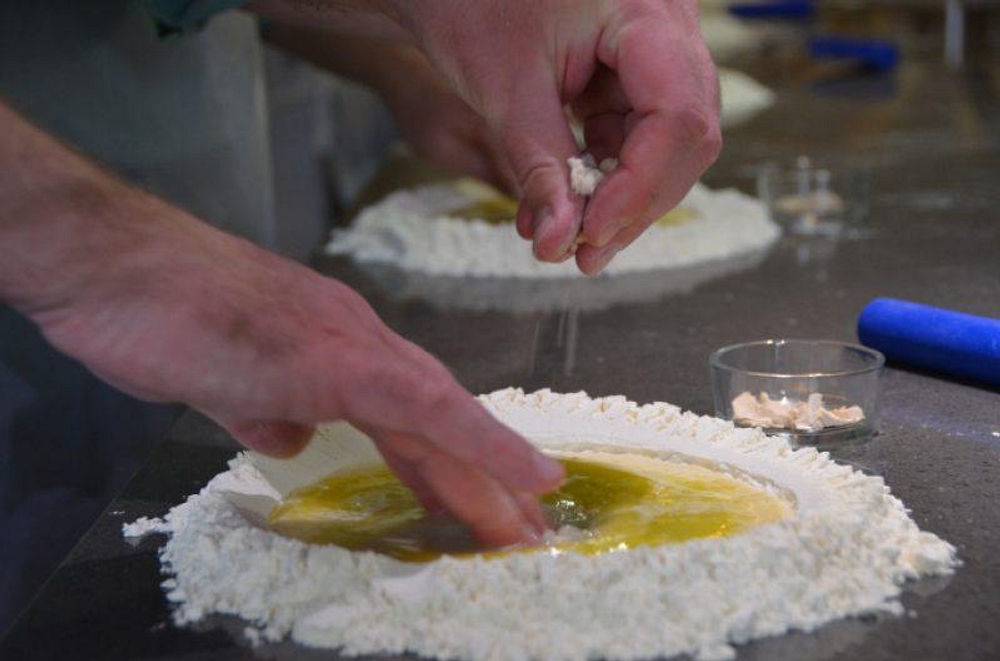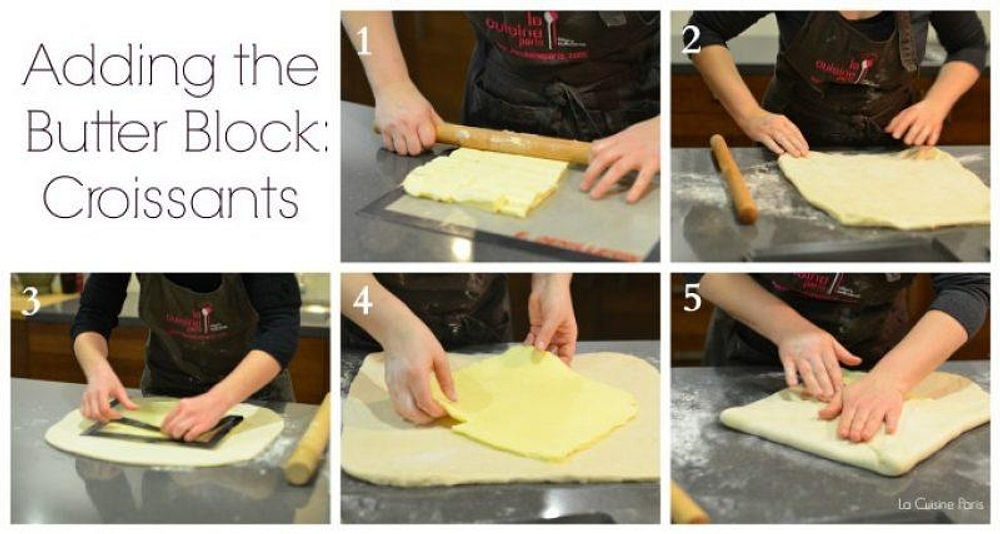
©LaCuisineParis
Did you know you can always sign up for our Croissant Video Class? It's step by step instruction and avaiable for you to start and stop when ever you like! You can check it out here !
Everyone knows that croissants contain quite a bit(!) of butter - that's what makes them so delicious and flaky. But have you ever tried to make croissants? If not, you'll definitely want to join us for a Croissant Class on your next Paris trip!
Over the last decade or so there isn't a croissant question we haven't been asked, and we are always happy to help in person or via email with any issues you may be having! But as a first stop, we've created this handy Cheatsheet that troubleshoots some of the most common issues our students encounter when they're baking their croissants back at home.
What butter should I use?
French boulangeries use butter that has a high fat content of 85 to 87 percent. For best results use quality butter with a high fat content and no additives or extra water. European style or imported butters can often be found in specialty grocery stores. For more buttery info, check out this blog article we wrote on French Butter.
What type of flour should I use?
Most French croissant recipes use pastry flour (T45) to produce a croissant with a light, delicate texture. Bread flour or All Purpose can be used to produce a chewier, more sturdy croissant.

©LaCuisineParis
Do I have to use Fresh yeast, what if I can only find dry, instant yeast?
Either yeast can be used, but they are not equal. If you replace fresh yeast with dry, for every gram of fresh yeast in the recipe, use ½ gram of instant dry yeast.
To what size do I roll out the butter block and the détrempe?
This is a tricky question - commonly asked - but there is no exact precise measurement to this step of the croissant making process. What is important is to make sure the détrempe is not rolled too thin (no less then 1cm thick) before adding the butter block. The block of butter must be the correct proportion to the détrempe, and the pâton should always be rolled to the same thickness between each turn. Refer back to the diagram on the recipe page or the step-by-step pictures below. Both can be used as a guide to see the proportions of the butter to the détrempe.
We use two different methods at our school for adding the butter block. For the first method as seen in the school recipe sheet diagram, prepare your détrempe and roll it out to a long rectangle then prepare your butter block to cover about 2/3 of the détrempe (it will be roughly the size of a piece of paper that has been folded in half). Make sure the butter is rolled out evenly and fully within the lines of the détrempe with about a 1/2cm border of dough. Place the butter block in the bottom 2/3rds of the détrempe, fold the end that is dough only over the butter (it will come to about the middle of the butter), then the other side of the dough.
For the second method, refer to the diagram below. You are wrapping the butter up with dough, almost like a present!

©LaCuisineParis
My butter is squishing out/escaping during the rolling!
Make sure the pâton has been rested long enough and that the butter is not too warm or it can start to melt out. Also make sure your work surface is sufficiently floured; if the détrempe sticks too much it can tear and create holes where the butter can leak out. If the dough is too warm, put it in the fridge for a few minutes before continuing. It also helps to work on a cold surface like granite or marble.
What if my dough looks like it has little lumps of butter in it, or the butter looks like it has broken up under the détrempe?
This happens when the pâton has been rolled out when the butter was too cold. Before completing the next turn, let your pâton rest outside the refrigerator for just a few minutes to let the butter soften a little. The butter needs to be cold, but it also needs to be pliable so it will spread smoothly with the détrempe.
What are the final dimensions that I roll my dough to before forming the croissants?
This depends, and is entirely up to you! The most important point is that your dough should be about 3-5mm thick. First plot out what you are thinking about making and then roll the dough to the size that will work best.
In our croissant classes, we are making several different shapes from one piece of dough. For the recipe we use, the dough rolls out perfectly to be the size of one of our baking sheets which is 40x30cm or 16x12 inches. Of course this size will depend though on the amount of dough you have depending on the recipe you use, so follow rule #1 of rolling the dough to be about 3-5mm thick.
If you are just going to make croissants, roll the dough to be the height of the triangle you want to work with, about 9 inches or 20cm is a good starting point. The base of the triangle will vary as well depending on how large or small you want your croissants to be (a good start is about 3in or 8cm).
For pain au chocolat, we use the chocolate sticks as a guide and form rectangles that are about 15cm by 8cm (3x6in).
Don't forget that the scraps can certainly be used! They should be layered on top of one another then rolled out as to not lose those layers. A fun idea is to cut them into strips, brush with melted butter and sprinkle with cinnamon sugar before twisting and baking into delicious snacks!

©LaCuisineParis
How long can croissants be kept in freezer?
Croissants can be frozen up to 2 months. This can happen at two stages during the process, as a pâton or after they have been shaped. They should be kept in an airtight container or plastic storage bag to maintain freshness.
How do I bake the croissants from frozen?
Allow to thaw in the fridge overnight, proof 1 to 2 hours, or until they jiggle like Jello when the pan is shaken. For best results, spray with water a couple of times during the proofing process. Brush with egg wash and then pop them in the oven!
A Few Last Tips and Pointers:
- Croissants need time and patience, it is best to not be in a rush.
- Chill it! Maintaining the détrempe and pâton chilled and giving it time to rest (at least 30 mins in the refrigerator) between the various stages of tourage is essential. The butter is also very sensitive to temperatures and considering the quantity, it’s best to keep it cold, if not it’ll begin to melt and “ooze out” of the dough and result in “uneven” layering
- Make sure butter is cold, but pliable. It is important that the butter spreads evenly for good.
- Croissants are sensitive to heat throughout the entire process. If your kitchen is hot, they will proof faster but make sure it is not too hot that the butter melts out of the croissants before baking. If your kitchen is on the cooler side, your croissants may take longer to proof, but they will get there!
- Croissant dough can be used to make so many different things. Roll with cinnamon sugar for a flaky take on cinnamon rolls, or flavored pastry cream or jam! Of course a piece of chocolate or two never hurts. :-

